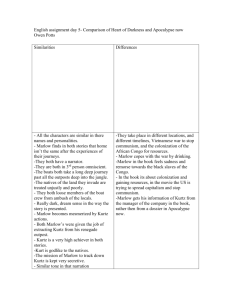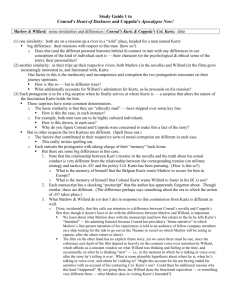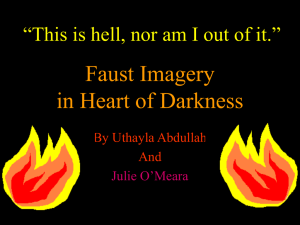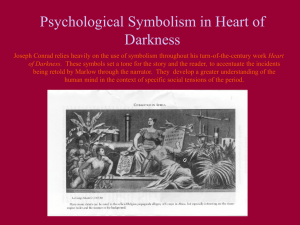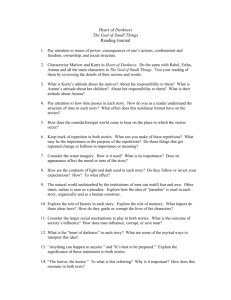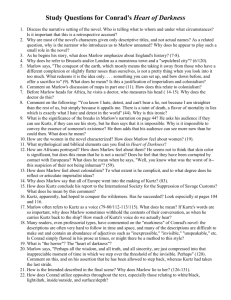Oppsummering av Apocalypse Now og Heart of Darkness. Laget av
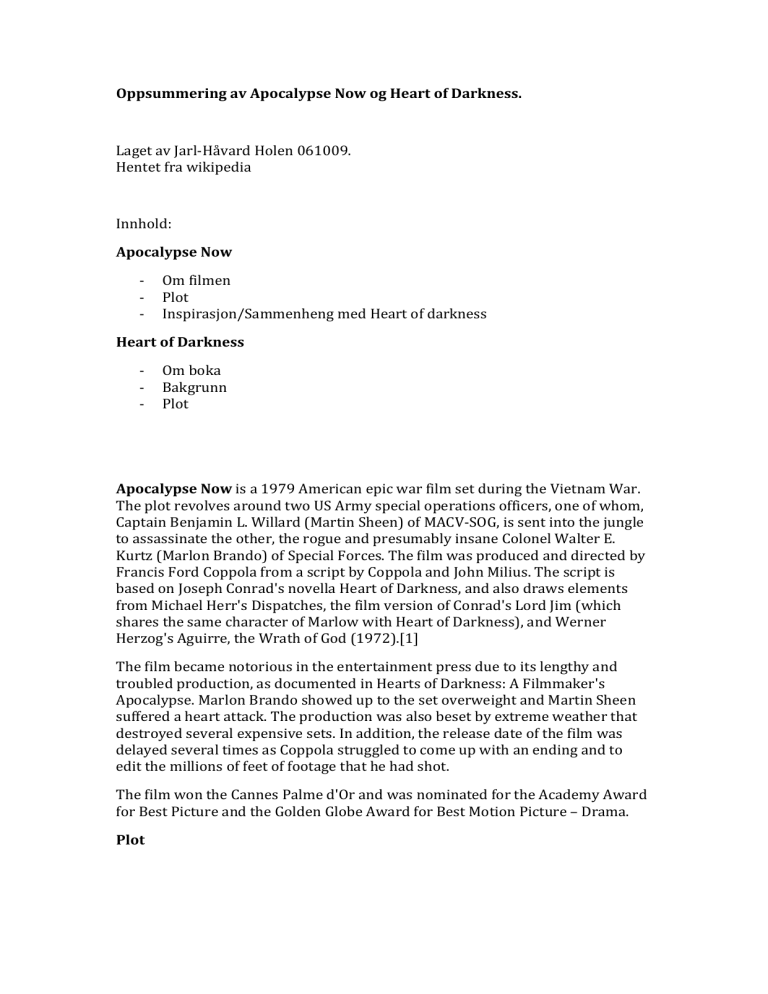
Oppsummering av Apocalypse Now og Heart of Darkness.
Laget av Jarl-‐Håvard Holen 061009.
Hentet fra wikipedia
Innhold:
Apocalypse Now
-‐ Om filmen
-‐ Plot
-‐ Inspirasjon/Sammenheng med Heart of darkness
Heart of Darkness
-‐ Om boka
-‐ Bakgrunn
-‐ Plot
Apocalypse Now is a 1979 American epic war film set during the Vietnam War.
The plot revolves around two US Army special operations officers, one of whom,
Captain Benjamin L. Willard (Martin Sheen) of MACV-‐SOG, is sent into the jungle to assassinate the other, the rogue and presumably insane Colonel Walter E.
Kurtz (Marlon Brando) of Special Forces. The film was produced and directed by
Francis Ford Coppola from a script by Coppola and John Milius. The script is based on Joseph Conrad's novella Heart of Darkness, and also draws elements from Michael Herr's Dispatches, the film version of Conrad's Lord Jim (which shares the same character of Marlow with Heart of Darkness), and Werner
Herzog's Aguirre, the Wrath of God (1972).[1]
The film became notorious in the entertainment press due to its lengthy and troubled production, as documented in Hearts of Darkness: A Filmmaker's
Apocalypse. Marlon Brando showed up to the set overweight and Martin Sheen suffered a heart attack. The production was also beset by extreme weather that destroyed several expensive sets. In addition, the release date of the film was delayed several times as Coppola struggled to come up with an ending and to edit the millions of feet of footage that he had shot.
The film won the Cannes Palme d'Or and was nominated for the Academy Award for Best Picture and the Golden Globe Award for Best Motion Picture – Drama.
Plot
The film opens, introducing Captain Benjamin L. Willard (Martin Sheen); a deeply troubled, seasoned special operations veteran. It is 1970. Willard has returned to Saigon from deployment in the field. He drinks excessively and appears to be having difficulty adjusting to life in the rear-‐area. Two intelligence officers, Lt. General Corman (G. D. Spradlin), Colonel Lucas (Harrison Ford) and a government man (Jerry Ziesmer), approach him with an assignment: journey up the legendary Nung River into the remote Cambodian jungle to find Colonel
Walter E. Kurtz (Marlon Brando), a member of the US Army Special Forces feared to have gone rogue.
They tell Willard that Kurtz, once considered a model officer and future general, has gone insane and is commanding a legion of his own Montagnard troops deep inside the forest in neutral Cambodia. Their claims are supported by very disturbing radio broadcasts and recordings made by Kurtz himself. Willard is ordered to undertake a mission to find Kurtz and terminate the Colonel's command "with extreme prejudice."
Willard joins the crew of a Navy Patrol Boat, Riverine (PBR), with an eclectic crew composed of QMC George Phillips (Albert Hall), the Navy PBR boat commander; GM3 Lance B. Johnson (Sam Bottoms), GM3 Tyrone Miller
(Laurence Fishburne), a.k.a. "Mr. Clean", and EN3 Jay "Chef" Hicks (Frederic
Forrest).
Willard and the PBR crew rendezvous with the 1/9 AirCav, commanded by
Lieutenant Colonel Bill Kilgore (Robert Duvall) for transport to the Nung River.
He initially refuses their request for transport until Kilgore, a keen surfer, is told by one of his men that Lance Johnson, a professional surfer, is a member of the boat's crew. Kilgore befriends Johnson, and later learns from one of his men that the beach down the coast which marks the opening to the river is perfect for surfing. This changes his mind about transporting Willard and the PBR and
Kilgore decides to capture the village. His men advise him that it's "Charlie's point" and heavily fortified. Dismissing this concern with the explanation that
"Charlie don't surf!," Kilgore orders his men to saddle up in the morning to capture the town and the beach.
Riding high above the coast in a fleet of Hueys accompanied by OH-‐6As, Kilgore launches his attack on the beach. The scene, famous for its use of Richard
Wagner's "Ride of the Valkyries," ends with the soldiers surfing the barely-‐ secured beach amidst skirmishes between infantry and VC. After helicopters swoop over the village and demolish all visible signs of resistance, a giant napalm strike in the nearby jungle dramatically marks the climax of the battle. Kilgore exults to Willard, "I love the smell of napalm in the morning... The smell, you know that gasoline smell... Smelled like, victory" as he recalls a battle in which a hill was bombarded with napalm for over twelve hours.
The lighting and mood darken as the boat navigates upstream and Willard's silent obsession with Kurtz deepens. Incidents on the journey include a run-‐in with a tiger while Willard and Chef search for mangoes. The boat continues up river and watches a USO show featuring Playboy Bunnies and a centerfold that degenerates into chaos.
Shortly after the Playmate performance, Phillips spots a sampan and orders an inspection over the objections of Willard. Initially reluctant to board the boat,
Chef hostilely searches it and one of the civilians makes a sudden movement towards a barrel, prompting Clean to open fire, killing nearly all the crew. The one concerned about the barrel, a young woman, lies dying. Chef discovers that the barrel contained the woman's pet puppy. Phillips insists on taking the survivor to receive medical attention, however, Willard ends the debate by shooting the survivor, calmly stating "I told you not to stop."
The boat moves up river to the American outpost at the Do Long bridge, the last
U.S. Army outpost on the river. The boat arrives during a North Vietnamese attack on the bridge, which is under constant construction. Upon arrival, Willard receives the last piece of the dossier from a lieutenant named Carlson, along with mail for the boat crewmen. Willard and Lance, who has taken LSD, go ashore and they make their way through the trenches where they encounter many panicked, leaderless soldiers. Realizing the situation has devolved into chaos, Willard and
Lance return to the boat. The chief tries to convince Willard not to continue on with his mission. In response, Willard snaps at Phillips to continue upriver. As the boat departs, the NVA launch an artillery strike that destroys the bridge.
The next day, Willard learns from the information he received at Do Lung that an
Army Lieutenant Colby was sent to find Kurtz a few months prior to Willard's assignment and is missing. While its crew is busy reading mail, the boat is ambushed by Viet Cong hiding in the trees by the river. Clean is killed as he listens to an audio tape from his mother. The chief, who had a close relationship with Clean, becomes increasingly hostile to Willard.
Montagnard villagers begin firing arrows at the boat as it approaches the camp.
The crew opens fire until the chief is hit by a spear. Willard attempts to assist the mortally wounded Phillips who tries to kill Willard by pulling him onto the speartip protruding from his chest. Willard grapples with Phillips until the man finally dies.
After arriving at Kurtz' outpost, Willard leaves Chef behind with orders to call in an airstrike on the village if he does not return and takes Johnson with him to the village. They are met by a manic freelance photographer (Dennis Hopper), who explains that Kurtz's greatness and philosophical skills inspire his people to follow him. Willard also encounters the missing Lt. Colby who is in a nearly catatonic state.
Willard is bound and brought before Kurtz in a darkened temple. Kurtz lectures him on his theories of war, humanity, and civilization. Kurtz explains his motives and philosophy in a haunting monologue in which he praises the ruthlessness of the Viet Cong he witnessed following one of his own humanitarian missions.
The scene changes to Chef attempting to call in the airstrike on the village as ordered by Willard. Chef is attacked and the scene cuts to Willard bound to a post outside in the pouring rain. Kurtz walks up to him and drops Chef's severed head into his lap.
Sometime later, a villager releases Willard's bonds and gives him a machete.
Willard enters Kurtz's chamber as Kurtz is making a recording, and attacks him with the machete. This entire sequence is set to "The End" by The Doors and juxtaposed with a ceremonial slaughtering of a water buffalo.
Lying bloody and dying on the ground, Kurtz whispers "The horror... the horror."
Willard descends the stairs from Kurtz' chamber and drops his weapon. The villagers do so as well. Willard walks through the now-‐silent crowd of natives and takes Johnson by the hand. He leads Johnson to the PBR, and they sail away as Kurtz's final words echo as the scene fades to black.
Adaptation
Although inspired by Joseph Conrad's Heart of Darkness, the film deviates extensively from its source material. The novella, based on Conrad's real experiences as a steam paddleboat captain in Africa, is set in the Congo Free
State during the 19th century. Kurtz and Marlow (who is named Willard in the movie) both work for a Belgian trading company that brutally exploits its native
African workers.
When Marlow arrives at Kurtz's outpost, he discovers that Kurtz has gone insane and is lording over a small tribe as a god. The novella ends with Kurtz dying on the trip back and the narrator musing about darkness of the human psyche: "the heart of an immense darkness."
In the novella, Marlow is the pilot of a river boat sent to collect ivory from
Kurtz's outpost, only gradually becoming infatuated with Kurtz. In fact, when he discovers Kurtz in terrible health, Marlow makes a concerted effort to bring him home safely. In the movie, Willard is an assassin dispatched to kill Kurtz.
Nevertheless, the depiction of Kurtz as a god-‐like leader of a tribe of natives and his malarial fever, Kurtz's written exclamation "Exterminate the brutes!" (which appears in the film as "Drop the bomb. Exterminate them All!") and his final lines
"The horror! The horror!" are taken from Conrad's novella.
Coppola argues that many episodes in the film—the spear and arrow attack on the boat, for example—respect the spirit of the novella and in particular its critique of the concepts of civilization and progress. Other episodes adapted by
Coppola, the Playboy bunnies (Sirens) exit, the lost souls, "taking me home" attempting to reach the boat and Kurtz' tribe of (white-‐faced) natives parting the canoes (gates of Hell) for Willard, (with Chef and Lance) to enter the camp are likened to Virgil and "The Inferno" (Divine Comedy) by Dante. While Coppola replaced European colonialism with American interventionism, the message of
Conrad's book is still clear.[3]
Coppola's interpretation of the iconic Kurtz character is often speculated to have been modeled after Tony Poe, a highly-‐decorated Vietnam-‐era Paramilitary
Officer from the CIA's Special Activities Division.[4] Poe's actions in Vietnam and his highly unorthodox and often savage methods of waging war show many similarities to those of the fictional Kurtz; for example, Poe was known to drop
severed heads into enemy-‐controlled villages as a form of psychological warfare and use human ears to record the number of enemies his indigenous troops had killed. He would send these ears back to his superiors as proof of the efficacy of his operations deep inside Laos.[5][6] Coppola, however, denies that Poe was a primary influence and instead says the character was loosely based on Special
Forces Colonel Robert Rheault, whose 1969 arrest over the murder of a suspected double agent Thai Khac Chuyen in Nha Trang generated substantial
Heart of Darkness is a novella written by Joseph Conrad. Before its 1902 publication, it appeared as a three-‐part series (1899) in Blackwood's Magazine.
It is widely regarded as a significant work of English literature and part of the
Western canon.
The story details an incident when Marlow, an Englishman, took a foreign assignment from a Belgian trading company as a ferry-‐boat captain in Africa.
Although Conrad does not specify the name of the river, at this time Congo Free
State, the location of the large and important Congo River, was a private colony of Belgium's King Leopold II. Marlow is employed to transport ivory downriver; however, his more pressing assignment is to return Kurtz, another ivory trader, to civilization in a cover up. Kurtz has a reputation throughout the region.
This very symbolic story is actually a story within a story, or frame narrative. It follows Marlow as he recounts, from dusk through to late night, to a group of men aboard a ship anchored in the Thames Estuary, his Congolese adventure.
The passage of time, and the darkening sky, during the fictive narrative parallels the atmosphere of the story. It should be noted from a structuralist point of view that Marlow is also the name of a town situated on the Thames further upstream from London.contemporary news coverage.[7]
Background
Eight and a half years before writing the book, Conrad had gone to serve as the captain of a Congo steamer. However, upon arriving in the Congo, he found his steamer damaged and under repair. He soon became ill and returned to Europe before ever serving as captain. Some of Conrad's experiences in the Congo, and the story's historic background, including possible models for Kurtz, are recounted in Adam Hochschild's King Leopold's Ghost.[citation needed]
The story-‐within-‐a-‐story device (called framed narrative in literary terms) that
Conrad chose for Heart of Darkness — one in which an unnamed narrator recounts Charles Marlow's recounting of his journey — has many literary precedents. Emily Brontë's Wuthering Heights and Mary Shelley's Frankenstein used a similar device, but the best known examples of the framed narrative include Geoffrey Chaucer's The Canterbury Tales, The Arabian Nights and
Samuel Taylor Coleridge's The Rime of the Ancient Mariner.
Plot summary
The story opens with five men, apparently old friends, on a boat on the Thames.
One man, Marlow, begins telling a story of a job he took as captain of a steamship in Africa. He begins by ruminating on how Britain's image among Ancient Roman officials must have been similar to Africa's image among 19th century British officials. He describes how his "dear aunt" used many of her contacts to secure the job for him. When he arrives at the job, he encounters many men he dislikes, as they strike him as untrustworthy. They speak often of a man named Kurtz, who has quite a reputation in many areas of expertise. He is somewhat of a rogue ivory collector, "essentially a great musician," a journalist, a skilled painter, and
"a universal genius."
Marlow learns that he is to travel up the river to retrieve Kurtz (if he is alive), who was evidently left alone in unfamiliar territory. However, Marlow's steamer needs extensive repairs, and he cannot leave until he receives rivets, which take a suspiciously long time to arrive. Marlow suspects the manager of deliberately delaying his trip to prevent Kurtz from stealing the manager's job.
Marlow is finally able to leave on his journey with five other white men and a group of cannibals they have hired to run the steamer. He notes that the cannibals use a respectable amount of restraint in not eating the white men, as their only food source is a small amount of rotting hippo meat, and they far outnumber the white men, or "pilgrims" as Marlow refers to them.
Marlow's steamer is attacked by natives while en route to Kurtz's station -‐ they are saved when Marlow blows the ship's steam whistle and frightens the natives into retreat. They arrive at the station and Marlow meets Kurtz's right-‐hand man, an unnamed Russian whose dress resembles a Harlequin and whose admiration and fear of Kurtz are palpable. The Russian explains that Kurtz is near death and that Kurtz had ordered the native tribes to attack the steam ship. Harlequin explains that Kurtz had used his guns and personal charisma to take over tribes of Africans and had used them to make war on other tribes for their ivory, which explains how Kurtz obtains so much ivory.
The Russian, who idolizes Kurtz, worries that Kurtz's reputation will be sullied by the Manager. Marlow promises to maintain Kurtz's reputation as a great man and advises the Russian to flee to friendly natives. The Russian thanks Marlow and leaves after collecting a few oddments.
At this point, near death, Kurtz has an enigmatic last desire to remain a part of the native culture, as exhibited by his ineffective striving toward tribal fire, dance and the darkness.
Marlow and his crew take the ailing Kurtz aboard their ship and depart. During this time, Kurtz is lodged in Marlow's pilothouse and Marlow begins to see that
Kurtz is every bit as grandiose as previously described. During this time, Kurtz gives Marlow a collection of papers and a photograph for safekeeping; both had
witnessed the Manager going through Kurtz's belongings. The photograph is of a beautiful girl whom Marlow assumes is Kurtz's love interest.
One night, Marlow happens upon Kurtz, obviously near death. As Marlow comes closer with a candle, Kurtz seems to experience a moment of clarity and speaks his last words: "The horror! The horror!" Marlow believes this to be Kurtz's reflection on the events of his life. Marlow does not inform the Manager or any of the other pilgrims of Kurtz's death; the news is instead broken by the Manager's child-‐servant.
Marlow later returns to his home city and is confronted by many people seeking things and ideas of Kurtz. Marlow eventually sees Kurtz's fiancée about a year later. She is still in mourning. She asks Marlow about Kurtz's death and Marlow informs her that his last words were her name — rather than, as really happened, "The horror! The horror!"
The story concludes as the scene returns to the trip on the Thames and mentions how it seems as though the boat is drifting into the heart of the darkness.

